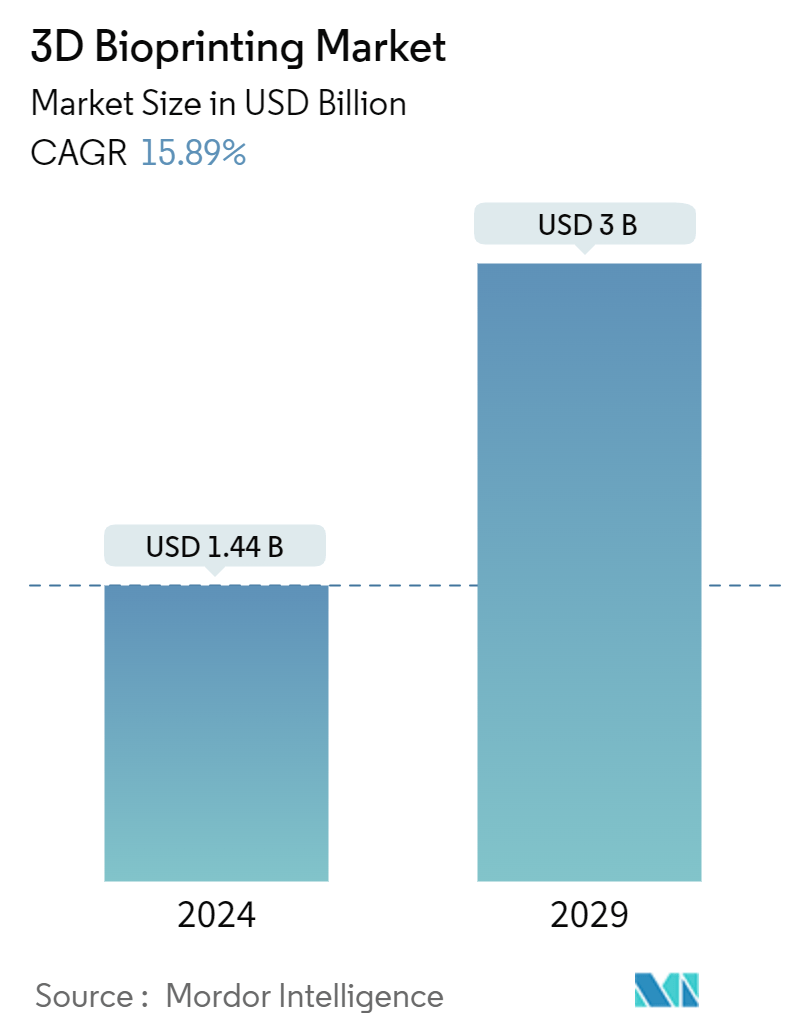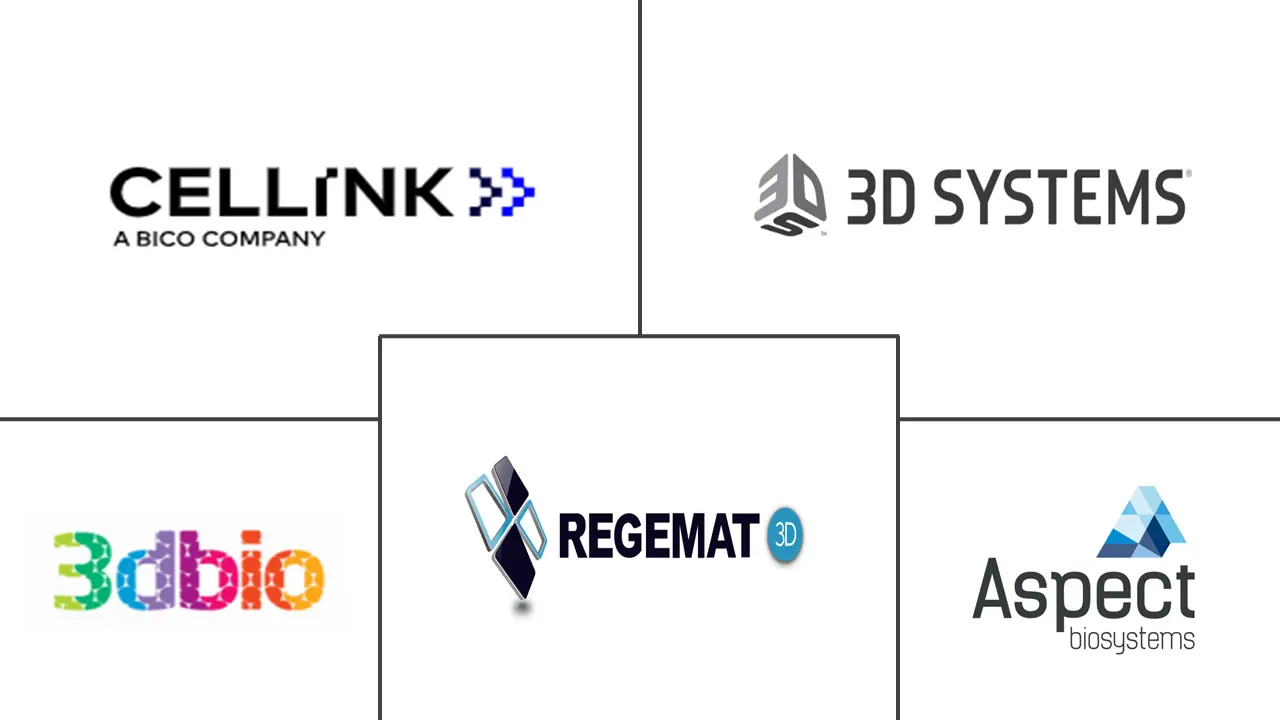Market Size of 3D Bioprinting Industry

| Study Period | 2019 - 2029 |
| Market Size (2024) | USD 1.44 Billion |
| Market Size (2029) | USD 3 Billion |
| CAGR (2024 - 2029) | 15.89 % |
| Fastest Growing Market | Asia Pacific |
| Largest Market | North America |
Major Players
*Disclaimer: Major Players sorted in no particular order |
3D Bioprinting Market Analysis
The 3D Bioprinting Market size is estimated at USD 1.44 billion in 2024, and is expected to reach USD 3 billion by 2029, growing at a CAGR of 15.89% during the forecast period (2024-2029).
- 3D bioprinting involves using bio-inks to print living cells in a layer-by-layer process, replicating the behavior and structures of natural tissues. Bioinks, utilized as a substance in bioprinting, consist of organic or artificial biomaterials that can be blended with viable cells. This innovative technology is utilized in fields like tissue engineering and pharmaceutical research, with the healthcare sector poised to embrace it rapidly.
- The utilization of technology and bioprinted structures allows researchers to examine the functionalities of the human body in vitro. In comparison to 2D in vitro studies, 3D bioprinted structures offer a higher level of biological relevance. The market growth is expected to be positively influenced by factors such as increased investment in research and development, advancements in technology, and the rising prevalence of chronic diseases. Additionally, this technology facilitates the design of personalized medical devices and implants tailored to meet the unique requirements of individual patients.
- 3D bioprinting has various applications in tissue engineering, bioengineering, and materials science. Additionally, it is being utilized more frequently in pharmaceutical development and drug validation. Bioprinting research focuses on clinical applications like 3D printed skin, bone grafts, implants, and even fully printed organs. These products are utilized in various clinical and research settings. While these modified medical products can replicate natural tissues and organs, they are not suitable as replacements for the original organs.
- According to WHO, 3D bioprinting has the potential to address important public health issues, like the need for human organ and tissue repair or replacement. The anticipated uses of this technology encompass research, training, and a variety of medical applications. The increase in research and development efforts, the rise in awareness of 3D bioprinting, the expanding elderly population, the adoption of advanced technologies, and the growth in healthcare spending all contribute positively to the 3D bioprinting market.
- Numerous enterprises are investing heavily in research and development to enhance technology by making significant advancements and introducing innovative products. One such example is Organovo, a medical laboratory and research firm leading the way in the United States in the field of 3D bioprinting. The company gained recognition by providing pharmaceutical companies with its exVive3D Liver Tissue for testing medicine toxicity. It has partnered with notable companies like Merck and L'Oréal in the healthcare sector and is now gearing up to launch its exVive3D Kidney Tissue product.
- Three-dimensional bioprinting technology holds promise in addressing various challenges in healthcare. For instance, functional bladders created from bioprinted tissue derived from patients' cells have already been effectively transplanted into humans. Scientists are continuously exploring the potential of bioprinting additional functional organs. Additionally, a potential future outcome of 3D bioprinting is the elimination of the need for organ donors, as personalized human organs can be produced using the patient's own cells or stem cells as a foundation.
- The COVID-19 pandemic prompted the 3D printing community to step up and offer their assistance in manufacturing essential medical equipment for hospitals that were facing challenges. Conversely, the expensive nature of 3D bioprinting and the absence of regulatory frameworks overseeing this technology are anticipated to impede the growth of the 3D bioprinting market. Moreover, the increasing socioethical issues surrounding the utilization of 3D bioprinted items are likely to pose a challenge to the market during the forecast period.
- The COVID-19 pandemic significantly expedited technological advancements in pharmaceuticals, medical devices, and manufacturing technologies due to disrupted supply chains and increased demand for treatments and materials. One of these advancements was 3D bioprinting, which involves arranging encapsulated cells or other biological materials (bio-inks) using a 3D printer to build tissue, organs, or biocompatible scaffolds that can enhance tissue growth.
3D Bioprinting Industry Segmentation
3D bioprinting is a distinct form of 3D printing that focuses on the creation and fabrication of bio-based materials, including organs, cells, tissues, and extracellular matrix. These materials find applications in various clinical and research settings.
The 3D bioprinting market is segmented by technology, component, application, and geography. By technology, the market is segmented into syringe/extrusion bioprinting, inkjet bioprinting, magnetic levitation bioprinting, and laser-assisted bioprinting. By component, the market is segmented into 3D bioprinters, biomaterials, and scaffolds. By application, the market is segmented into drug testing and development, regenerative medicine, food testing, and research. By geography, the market is segmented into North America, Europe, Asia-Pacific, and the Rest of the World. For each segment, the market sizing and forecasts were made on the basis of value (USD).
| By Technology | |
| Syringe/Extrusion Bioprinting | |
| Inkjet Bioprinting | |
| Magnetic Levitation Bioprinting | |
| Laser-assisted Bioprinting | |
| Other Technologies |
| By Component | |
| 3D Bioprinters | |
| Biomaterials | |
| Scaffolds |
| By Application | |
| Drug Testing and Development | |
| Regenerative Medicine | |
| Food Testing | |
| Research | |
| Other Applications |
| By Geography | ||||||
| ||||||
| ||||||
| ||||||
| Rest of the World |
3D Bioprinting Market Size Summary
The 3D bioprinting market is experiencing significant growth, driven by technological advancements in healthcare and pharmaceuticals, alongside supportive government regulations and increased R&D investments. This innovative field encompasses various techniques such as direct writing, photolithography, and microfluidics, which are revolutionizing healthcare applications like organ prototyping and tissue engineering. The market is particularly benefiting from the demand for ethical and cost-effective alternatives to animal testing in drug development, as bioprinted tissues offer a more accurate and humane solution. Companies like Organovo are at the forefront, developing bioprinted tissues for drug toxicity testing, while the COVID-19 pandemic has further accelerated the adoption of these technologies across pharmaceutical and medical sectors.
Regionally, Asia-Pacific is emerging as the fastest-growing market, with China and India leading the charge due to strong government support and a burgeoning healthcare sector. In China, significant research and development in bio-manufacturing and 3D bioprinting technologies are being supported by national and local government initiatives, fostering rapid advancements and adoption. Similarly, India's healthcare industry is expanding rapidly, with startups and collaborations with international institutions driving innovation in bioprinting technologies. The competitive landscape features major players like 3D Systems Corporation and Cellink AB, who are actively expanding their capabilities and partnerships to capture a larger share of the market.
3D Bioprinting Market Size - Table of Contents
-
1. MARKET INSIGHTS
-
1.1 Market Overview
-
1.2 Industry Attractiveness - Porter's Five Forces Analysis
-
1.2.1 Bargaining Power of Suppliers
-
1.2.2 Bargaining Power of Consumers
-
1.2.3 Threat of New Entrants
-
1.2.4 Threat of Substitutes
-
1.2.5 Intensity of Competitive Rivalry
-
-
1.3 Impact of COVID-19 on the 3D Bioprinting Market
-
-
2. MARKET SEGMENTATION
-
2.1 By Technology
-
2.1.1 Syringe/Extrusion Bioprinting
-
2.1.2 Inkjet Bioprinting
-
2.1.3 Magnetic Levitation Bioprinting
-
2.1.4 Laser-assisted Bioprinting
-
2.1.5 Other Technologies
-
-
2.2 By Component
-
2.2.1 3D Bioprinters
-
2.2.2 Biomaterials
-
2.2.3 Scaffolds
-
-
2.3 By Application
-
2.3.1 Drug Testing and Development
-
2.3.2 Regenerative Medicine
-
2.3.3 Food Testing
-
2.3.4 Research
-
2.3.5 Other Applications
-
-
2.4 By Geography
-
2.4.1 North America
-
2.4.1.1 United States
-
2.4.1.2 Canada
-
-
2.4.2 Europe
-
2.4.2.1 United Kingdom
-
2.4.2.2 Germany
-
2.4.2.3 France
-
2.4.2.4 Rest of Europe
-
-
2.4.3 Asia-Pacific
-
2.4.3.1 China
-
2.4.3.2 Japan
-
2.4.3.3 India
-
2.4.3.4 Rest of Asia-Pacific
-
-
2.4.4 Rest of the World
-
-
3D Bioprinting Market Size FAQs
How big is the 3D Bioprinting Market?
The 3D Bioprinting Market size is expected to reach USD 1.44 billion in 2024 and grow at a CAGR of 15.89% to reach USD 3 billion by 2029.
What is the current 3D Bioprinting Market size?
In 2024, the 3D Bioprinting Market size is expected to reach USD 1.44 billion.

